Nursing Intervention and Pathophysiology for Acute Life-Threatening Disease: A Case Study of Mr. Das
VerifiedAdded on 2023/06/11
|6
|1873
|151
AI Summary
This case study discusses the nursing intervention and pathophysiology for acute life-threatening disease in the context of Mr. Das. It covers topics such as myocardial infarction, tachycardia, hypertension, dyspnoea, and the mechanism of action of Furosemide and Glyceryl trinitrate.
Contribute Materials
Your contribution can guide someone’s learning journey. Share your
documents today.
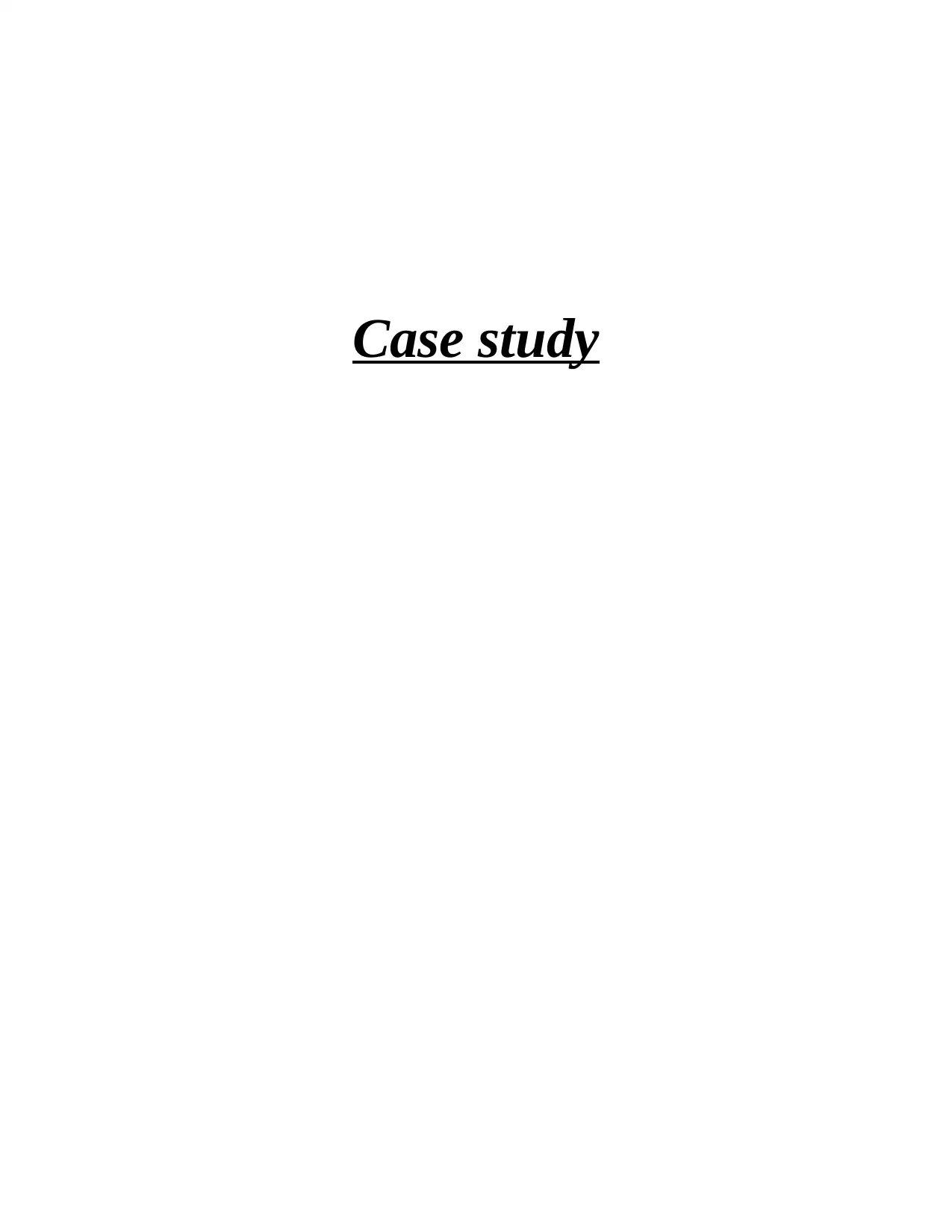
Case study
Secure Best Marks with AI Grader
Need help grading? Try our AI Grader for instant feedback on your assignments.
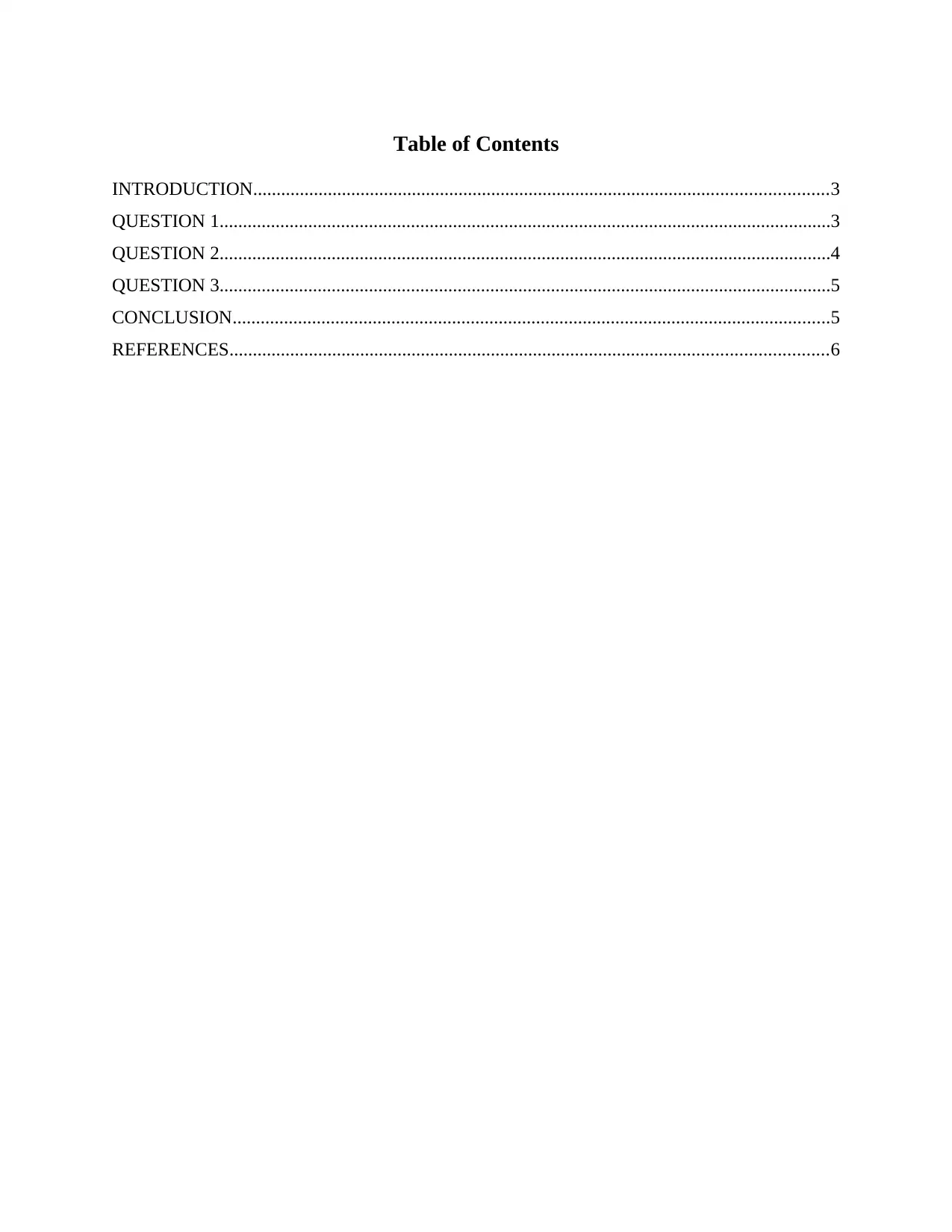
Table of Contents
INTRODUCTION...........................................................................................................................3
QUESTION 1...................................................................................................................................3
QUESTION 2...................................................................................................................................4
QUESTION 3...................................................................................................................................5
CONCLUSION................................................................................................................................5
REFERENCES................................................................................................................................6
INTRODUCTION...........................................................................................................................3
QUESTION 1...................................................................................................................................3
QUESTION 2...................................................................................................................................4
QUESTION 3...................................................................................................................................5
CONCLUSION................................................................................................................................5
REFERENCES................................................................................................................................6
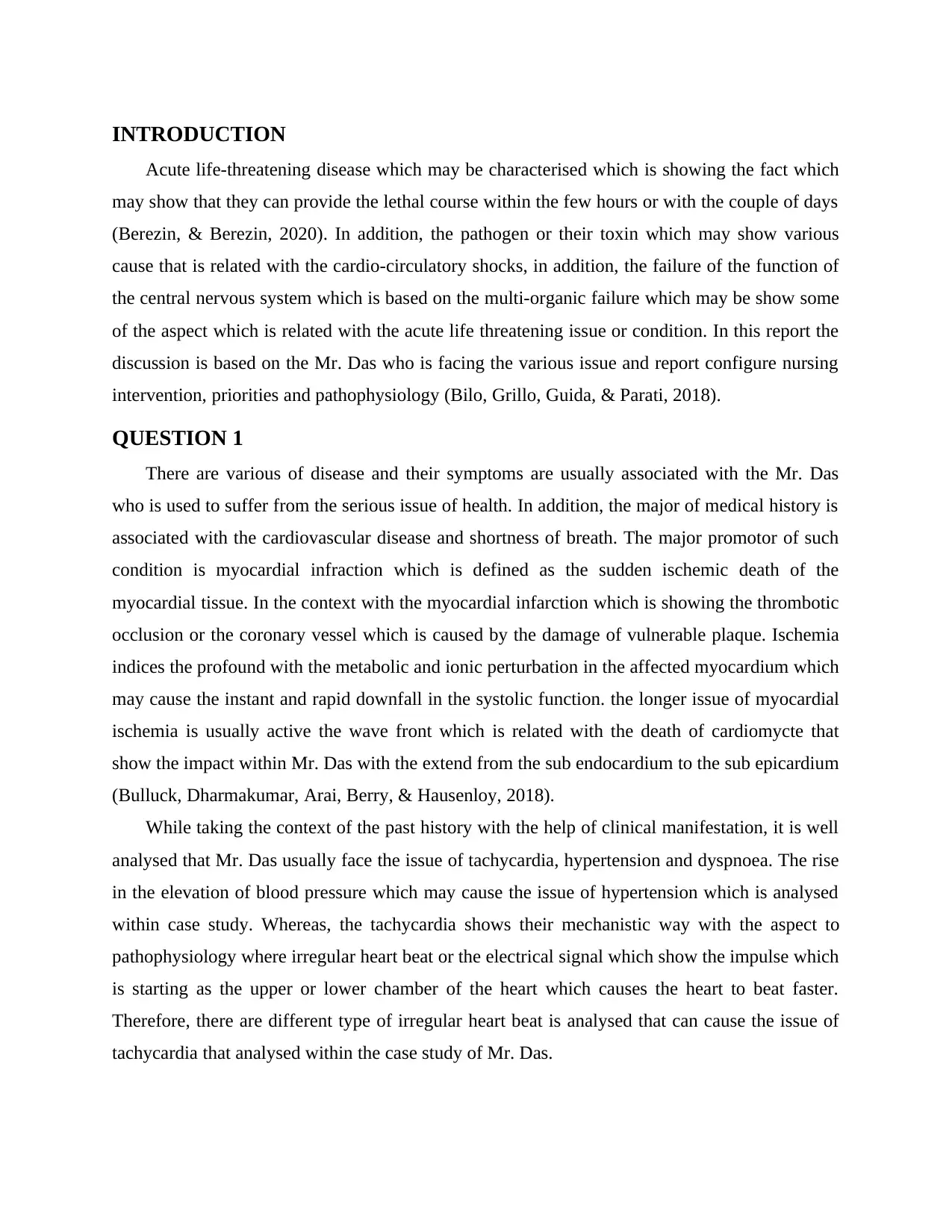
INTRODUCTION
Acute life-threatening disease which may be characterised which is showing the fact which
may show that they can provide the lethal course within the few hours or with the couple of days
(Berezin, & Berezin, 2020). In addition, the pathogen or their toxin which may show various
cause that is related with the cardio-circulatory shocks, in addition, the failure of the function of
the central nervous system which is based on the multi-organic failure which may be show some
of the aspect which is related with the acute life threatening issue or condition. In this report the
discussion is based on the Mr. Das who is facing the various issue and report configure nursing
intervention, priorities and pathophysiology (Bilo, Grillo, Guida, & Parati, 2018).
QUESTION 1
There are various of disease and their symptoms are usually associated with the Mr. Das
who is used to suffer from the serious issue of health. In addition, the major of medical history is
associated with the cardiovascular disease and shortness of breath. The major promotor of such
condition is myocardial infraction which is defined as the sudden ischemic death of the
myocardial tissue. In the context with the myocardial infarction which is showing the thrombotic
occlusion or the coronary vessel which is caused by the damage of vulnerable plaque. Ischemia
indices the profound with the metabolic and ionic perturbation in the affected myocardium which
may cause the instant and rapid downfall in the systolic function. the longer issue of myocardial
ischemia is usually active the wave front which is related with the death of cardiomycte that
show the impact within Mr. Das with the extend from the sub endocardium to the sub epicardium
(Bulluck, Dharmakumar, Arai, Berry, & Hausenloy, 2018).
While taking the context of the past history with the help of clinical manifestation, it is well
analysed that Mr. Das usually face the issue of tachycardia, hypertension and dyspnoea. The rise
in the elevation of blood pressure which may cause the issue of hypertension which is analysed
within case study. Whereas, the tachycardia shows their mechanistic way with the aspect to
pathophysiology where irregular heart beat or the electrical signal which show the impulse which
is starting as the upper or lower chamber of the heart which causes the heart to beat faster.
Therefore, there are different type of irregular heart beat is analysed that can cause the issue of
tachycardia that analysed within the case study of Mr. Das.
Acute life-threatening disease which may be characterised which is showing the fact which
may show that they can provide the lethal course within the few hours or with the couple of days
(Berezin, & Berezin, 2020). In addition, the pathogen or their toxin which may show various
cause that is related with the cardio-circulatory shocks, in addition, the failure of the function of
the central nervous system which is based on the multi-organic failure which may be show some
of the aspect which is related with the acute life threatening issue or condition. In this report the
discussion is based on the Mr. Das who is facing the various issue and report configure nursing
intervention, priorities and pathophysiology (Bilo, Grillo, Guida, & Parati, 2018).
QUESTION 1
There are various of disease and their symptoms are usually associated with the Mr. Das
who is used to suffer from the serious issue of health. In addition, the major of medical history is
associated with the cardiovascular disease and shortness of breath. The major promotor of such
condition is myocardial infraction which is defined as the sudden ischemic death of the
myocardial tissue. In the context with the myocardial infarction which is showing the thrombotic
occlusion or the coronary vessel which is caused by the damage of vulnerable plaque. Ischemia
indices the profound with the metabolic and ionic perturbation in the affected myocardium which
may cause the instant and rapid downfall in the systolic function. the longer issue of myocardial
ischemia is usually active the wave front which is related with the death of cardiomycte that
show the impact within Mr. Das with the extend from the sub endocardium to the sub epicardium
(Bulluck, Dharmakumar, Arai, Berry, & Hausenloy, 2018).
While taking the context of the past history with the help of clinical manifestation, it is well
analysed that Mr. Das usually face the issue of tachycardia, hypertension and dyspnoea. The rise
in the elevation of blood pressure which may cause the issue of hypertension which is analysed
within case study. Whereas, the tachycardia shows their mechanistic way with the aspect to
pathophysiology where irregular heart beat or the electrical signal which show the impulse which
is starting as the upper or lower chamber of the heart which causes the heart to beat faster.
Therefore, there are different type of irregular heart beat is analysed that can cause the issue of
tachycardia that analysed within the case study of Mr. Das.
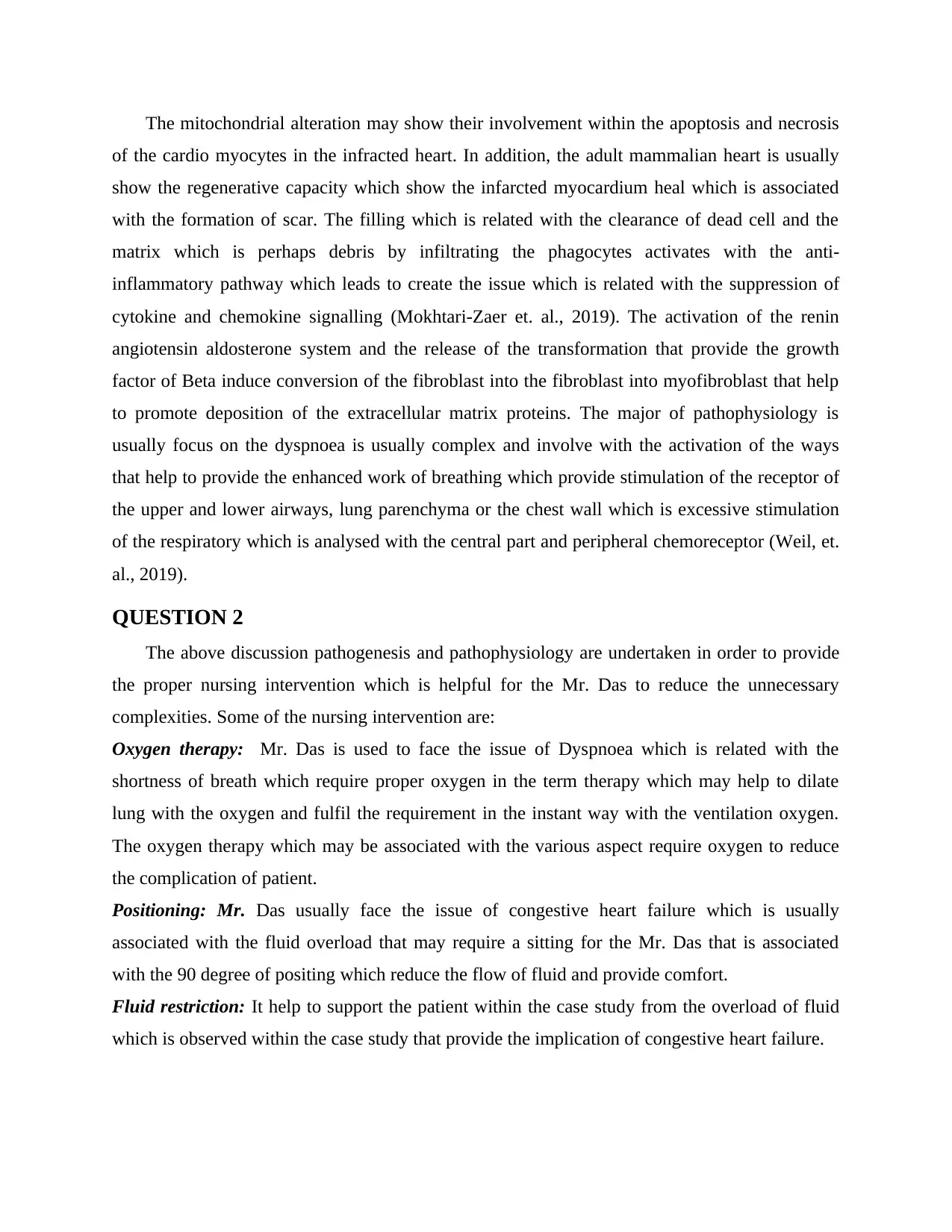
The mitochondrial alteration may show their involvement within the apoptosis and necrosis
of the cardio myocytes in the infracted heart. In addition, the adult mammalian heart is usually
show the regenerative capacity which show the infarcted myocardium heal which is associated
with the formation of scar. The filling which is related with the clearance of dead cell and the
matrix which is perhaps debris by infiltrating the phagocytes activates with the anti-
inflammatory pathway which leads to create the issue which is related with the suppression of
cytokine and chemokine signalling (Mokhtari‐Zaer et. al., 2019). The activation of the renin
angiotensin aldosterone system and the release of the transformation that provide the growth
factor of Beta induce conversion of the fibroblast into the fibroblast into myofibroblast that help
to promote deposition of the extracellular matrix proteins. The major of pathophysiology is
usually focus on the dyspnoea is usually complex and involve with the activation of the ways
that help to provide the enhanced work of breathing which provide stimulation of the receptor of
the upper and lower airways, lung parenchyma or the chest wall which is excessive stimulation
of the respiratory which is analysed with the central part and peripheral chemoreceptor (Weil, et.
al., 2019).
QUESTION 2
The above discussion pathogenesis and pathophysiology are undertaken in order to provide
the proper nursing intervention which is helpful for the Mr. Das to reduce the unnecessary
complexities. Some of the nursing intervention are:
Oxygen therapy: Mr. Das is used to face the issue of Dyspnoea which is related with the
shortness of breath which require proper oxygen in the term therapy which may help to dilate
lung with the oxygen and fulfil the requirement in the instant way with the ventilation oxygen.
The oxygen therapy which may be associated with the various aspect require oxygen to reduce
the complication of patient.
Positioning: Mr. Das usually face the issue of congestive heart failure which is usually
associated with the fluid overload that may require a sitting for the Mr. Das that is associated
with the 90 degree of positing which reduce the flow of fluid and provide comfort.
Fluid restriction: It help to support the patient within the case study from the overload of fluid
which is observed within the case study that provide the implication of congestive heart failure.
of the cardio myocytes in the infracted heart. In addition, the adult mammalian heart is usually
show the regenerative capacity which show the infarcted myocardium heal which is associated
with the formation of scar. The filling which is related with the clearance of dead cell and the
matrix which is perhaps debris by infiltrating the phagocytes activates with the anti-
inflammatory pathway which leads to create the issue which is related with the suppression of
cytokine and chemokine signalling (Mokhtari‐Zaer et. al., 2019). The activation of the renin
angiotensin aldosterone system and the release of the transformation that provide the growth
factor of Beta induce conversion of the fibroblast into the fibroblast into myofibroblast that help
to promote deposition of the extracellular matrix proteins. The major of pathophysiology is
usually focus on the dyspnoea is usually complex and involve with the activation of the ways
that help to provide the enhanced work of breathing which provide stimulation of the receptor of
the upper and lower airways, lung parenchyma or the chest wall which is excessive stimulation
of the respiratory which is analysed with the central part and peripheral chemoreceptor (Weil, et.
al., 2019).
QUESTION 2
The above discussion pathogenesis and pathophysiology are undertaken in order to provide
the proper nursing intervention which is helpful for the Mr. Das to reduce the unnecessary
complexities. Some of the nursing intervention are:
Oxygen therapy: Mr. Das is used to face the issue of Dyspnoea which is related with the
shortness of breath which require proper oxygen in the term therapy which may help to dilate
lung with the oxygen and fulfil the requirement in the instant way with the ventilation oxygen.
The oxygen therapy which may be associated with the various aspect require oxygen to reduce
the complication of patient.
Positioning: Mr. Das usually face the issue of congestive heart failure which is usually
associated with the fluid overload that may require a sitting for the Mr. Das that is associated
with the 90 degree of positing which reduce the flow of fluid and provide comfort.
Fluid restriction: It help to support the patient within the case study from the overload of fluid
which is observed within the case study that provide the implication of congestive heart failure.
Secure Best Marks with AI Grader
Need help grading? Try our AI Grader for instant feedback on your assignments.
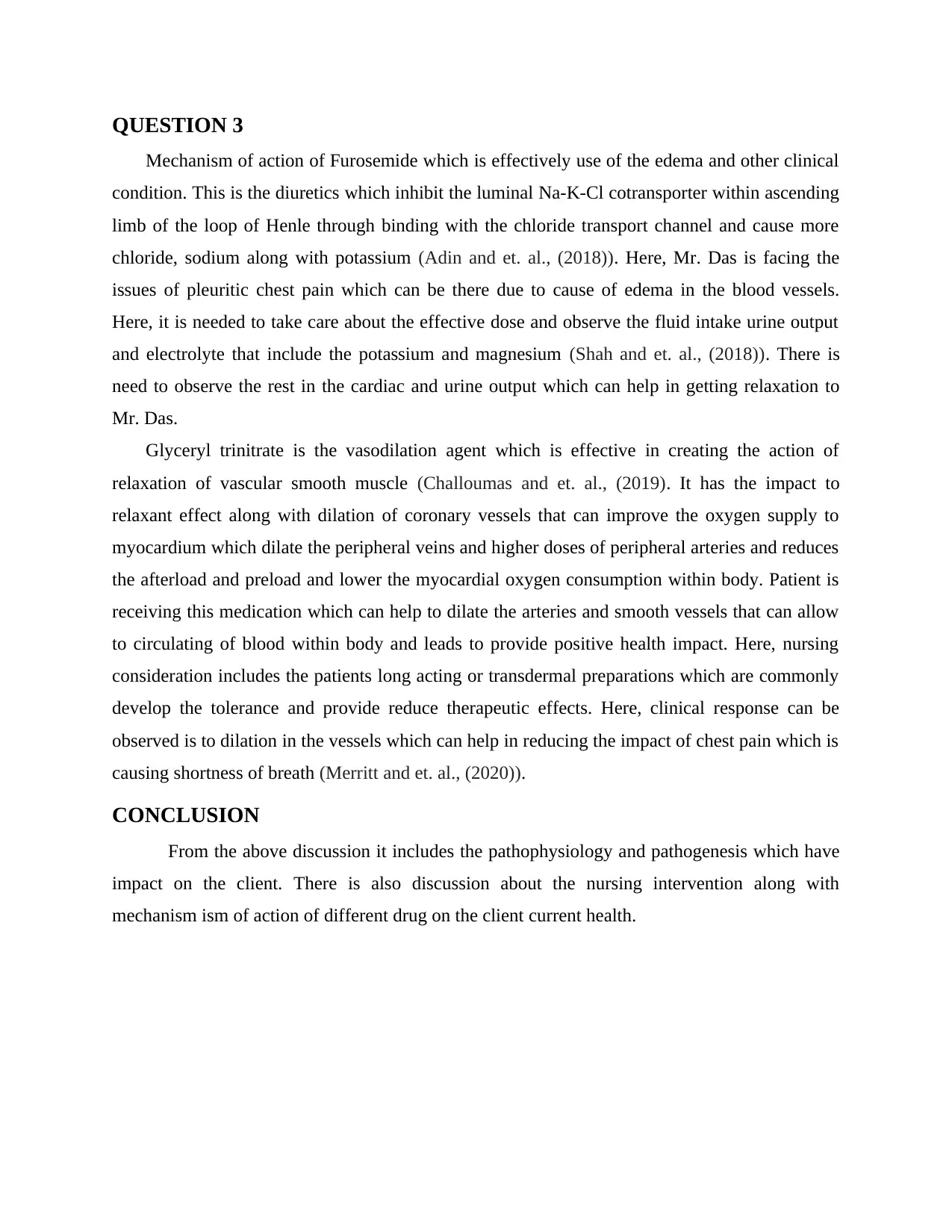
QUESTION 3
Mechanism of action of Furosemide which is effectively use of the edema and other clinical
condition. This is the diuretics which inhibit the luminal Na-K-Cl cotransporter within ascending
limb of the loop of Henle through binding with the chloride transport channel and cause more
chloride, sodium along with potassium (Adin and et. al., (2018)). Here, Mr. Das is facing the
issues of pleuritic chest pain which can be there due to cause of edema in the blood vessels.
Here, it is needed to take care about the effective dose and observe the fluid intake urine output
and electrolyte that include the potassium and magnesium (Shah and et. al., (2018)). There is
need to observe the rest in the cardiac and urine output which can help in getting relaxation to
Mr. Das.
Glyceryl trinitrate is the vasodilation agent which is effective in creating the action of
relaxation of vascular smooth muscle (Challoumas and et. al., (2019). It has the impact to
relaxant effect along with dilation of coronary vessels that can improve the oxygen supply to
myocardium which dilate the peripheral veins and higher doses of peripheral arteries and reduces
the afterload and preload and lower the myocardial oxygen consumption within body. Patient is
receiving this medication which can help to dilate the arteries and smooth vessels that can allow
to circulating of blood within body and leads to provide positive health impact. Here, nursing
consideration includes the patients long acting or transdermal preparations which are commonly
develop the tolerance and provide reduce therapeutic effects. Here, clinical response can be
observed is to dilation in the vessels which can help in reducing the impact of chest pain which is
causing shortness of breath (Merritt and et. al., (2020)).
CONCLUSION
From the above discussion it includes the pathophysiology and pathogenesis which have
impact on the client. There is also discussion about the nursing intervention along with
mechanism ism of action of different drug on the client current health.
Mechanism of action of Furosemide which is effectively use of the edema and other clinical
condition. This is the diuretics which inhibit the luminal Na-K-Cl cotransporter within ascending
limb of the loop of Henle through binding with the chloride transport channel and cause more
chloride, sodium along with potassium (Adin and et. al., (2018)). Here, Mr. Das is facing the
issues of pleuritic chest pain which can be there due to cause of edema in the blood vessels.
Here, it is needed to take care about the effective dose and observe the fluid intake urine output
and electrolyte that include the potassium and magnesium (Shah and et. al., (2018)). There is
need to observe the rest in the cardiac and urine output which can help in getting relaxation to
Mr. Das.
Glyceryl trinitrate is the vasodilation agent which is effective in creating the action of
relaxation of vascular smooth muscle (Challoumas and et. al., (2019). It has the impact to
relaxant effect along with dilation of coronary vessels that can improve the oxygen supply to
myocardium which dilate the peripheral veins and higher doses of peripheral arteries and reduces
the afterload and preload and lower the myocardial oxygen consumption within body. Patient is
receiving this medication which can help to dilate the arteries and smooth vessels that can allow
to circulating of blood within body and leads to provide positive health impact. Here, nursing
consideration includes the patients long acting or transdermal preparations which are commonly
develop the tolerance and provide reduce therapeutic effects. Here, clinical response can be
observed is to dilation in the vessels which can help in reducing the impact of chest pain which is
causing shortness of breath (Merritt and et. al., (2020)).
CONCLUSION
From the above discussion it includes the pathophysiology and pathogenesis which have
impact on the client. There is also discussion about the nursing intervention along with
mechanism ism of action of different drug on the client current health.
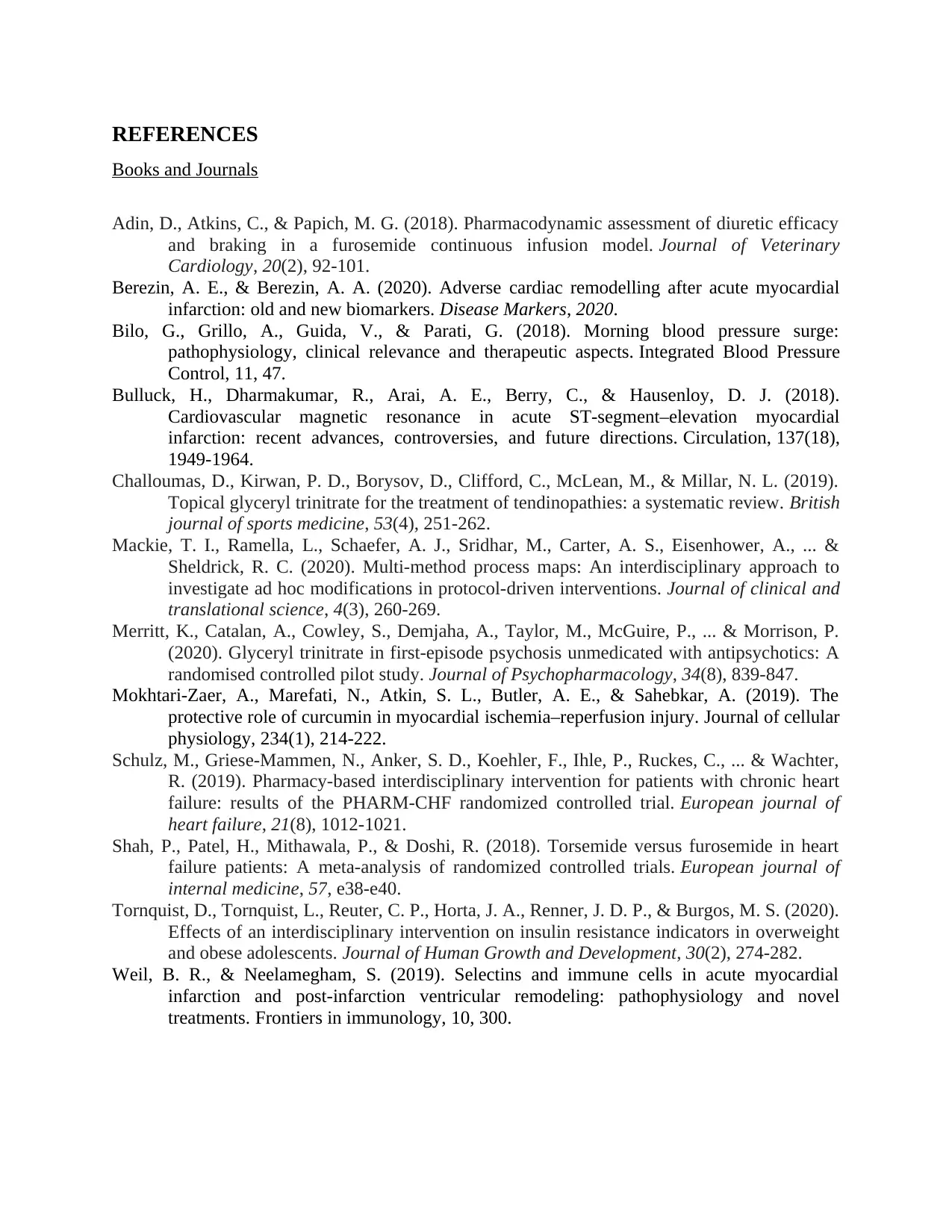
REFERENCES
Books and Journals
Adin, D., Atkins, C., & Papich, M. G. (2018). Pharmacodynamic assessment of diuretic efficacy
and braking in a furosemide continuous infusion model. Journal of Veterinary
Cardiology, 20(2), 92-101.
Berezin, A. E., & Berezin, A. A. (2020). Adverse cardiac remodelling after acute myocardial
infarction: old and new biomarkers. Disease Markers, 2020.
Bilo, G., Grillo, A., Guida, V., & Parati, G. (2018). Morning blood pressure surge:
pathophysiology, clinical relevance and therapeutic aspects. Integrated Blood Pressure
Control, 11, 47.
Bulluck, H., Dharmakumar, R., Arai, A. E., Berry, C., & Hausenloy, D. J. (2018).
Cardiovascular magnetic resonance in acute ST-segment–elevation myocardial
infarction: recent advances, controversies, and future directions. Circulation, 137(18),
1949-1964.
Challoumas, D., Kirwan, P. D., Borysov, D., Clifford, C., McLean, M., & Millar, N. L. (2019).
Topical glyceryl trinitrate for the treatment of tendinopathies: a systematic review. British
journal of sports medicine, 53(4), 251-262.
Mackie, T. I., Ramella, L., Schaefer, A. J., Sridhar, M., Carter, A. S., Eisenhower, A., ... &
Sheldrick, R. C. (2020). Multi-method process maps: An interdisciplinary approach to
investigate ad hoc modifications in protocol-driven interventions. Journal of clinical and
translational science, 4(3), 260-269.
Merritt, K., Catalan, A., Cowley, S., Demjaha, A., Taylor, M., McGuire, P., ... & Morrison, P.
(2020). Glyceryl trinitrate in first-episode psychosis unmedicated with antipsychotics: A
randomised controlled pilot study. Journal of Psychopharmacology, 34(8), 839-847.
Mokhtari‐Zaer, A., Marefati, N., Atkin, S. L., Butler, A. E., & Sahebkar, A. (2019). The
protective role of curcumin in myocardial ischemia–reperfusion injury. Journal of cellular
physiology, 234(1), 214-222.
Schulz, M., Griese‐Mammen, N., Anker, S. D., Koehler, F., Ihle, P., Ruckes, C., ... & Wachter,
R. (2019). Pharmacy‐based interdisciplinary intervention for patients with chronic heart
failure: results of the PHARM‐CHF randomized controlled trial. European journal of
heart failure, 21(8), 1012-1021.
Shah, P., Patel, H., Mithawala, P., & Doshi, R. (2018). Torsemide versus furosemide in heart
failure patients: A meta-analysis of randomized controlled trials. European journal of
internal medicine, 57, e38-e40.
Tornquist, D., Tornquist, L., Reuter, C. P., Horta, J. A., Renner, J. D. P., & Burgos, M. S. (2020).
Effects of an interdisciplinary intervention on insulin resistance indicators in overweight
and obese adolescents. Journal of Human Growth and Development, 30(2), 274-282.
Weil, B. R., & Neelamegham, S. (2019). Selectins and immune cells in acute myocardial
infarction and post-infarction ventricular remodeling: pathophysiology and novel
treatments. Frontiers in immunology, 10, 300.
Books and Journals
Adin, D., Atkins, C., & Papich, M. G. (2018). Pharmacodynamic assessment of diuretic efficacy
and braking in a furosemide continuous infusion model. Journal of Veterinary
Cardiology, 20(2), 92-101.
Berezin, A. E., & Berezin, A. A. (2020). Adverse cardiac remodelling after acute myocardial
infarction: old and new biomarkers. Disease Markers, 2020.
Bilo, G., Grillo, A., Guida, V., & Parati, G. (2018). Morning blood pressure surge:
pathophysiology, clinical relevance and therapeutic aspects. Integrated Blood Pressure
Control, 11, 47.
Bulluck, H., Dharmakumar, R., Arai, A. E., Berry, C., & Hausenloy, D. J. (2018).
Cardiovascular magnetic resonance in acute ST-segment–elevation myocardial
infarction: recent advances, controversies, and future directions. Circulation, 137(18),
1949-1964.
Challoumas, D., Kirwan, P. D., Borysov, D., Clifford, C., McLean, M., & Millar, N. L. (2019).
Topical glyceryl trinitrate for the treatment of tendinopathies: a systematic review. British
journal of sports medicine, 53(4), 251-262.
Mackie, T. I., Ramella, L., Schaefer, A. J., Sridhar, M., Carter, A. S., Eisenhower, A., ... &
Sheldrick, R. C. (2020). Multi-method process maps: An interdisciplinary approach to
investigate ad hoc modifications in protocol-driven interventions. Journal of clinical and
translational science, 4(3), 260-269.
Merritt, K., Catalan, A., Cowley, S., Demjaha, A., Taylor, M., McGuire, P., ... & Morrison, P.
(2020). Glyceryl trinitrate in first-episode psychosis unmedicated with antipsychotics: A
randomised controlled pilot study. Journal of Psychopharmacology, 34(8), 839-847.
Mokhtari‐Zaer, A., Marefati, N., Atkin, S. L., Butler, A. E., & Sahebkar, A. (2019). The
protective role of curcumin in myocardial ischemia–reperfusion injury. Journal of cellular
physiology, 234(1), 214-222.
Schulz, M., Griese‐Mammen, N., Anker, S. D., Koehler, F., Ihle, P., Ruckes, C., ... & Wachter,
R. (2019). Pharmacy‐based interdisciplinary intervention for patients with chronic heart
failure: results of the PHARM‐CHF randomized controlled trial. European journal of
heart failure, 21(8), 1012-1021.
Shah, P., Patel, H., Mithawala, P., & Doshi, R. (2018). Torsemide versus furosemide in heart
failure patients: A meta-analysis of randomized controlled trials. European journal of
internal medicine, 57, e38-e40.
Tornquist, D., Tornquist, L., Reuter, C. P., Horta, J. A., Renner, J. D. P., & Burgos, M. S. (2020).
Effects of an interdisciplinary intervention on insulin resistance indicators in overweight
and obese adolescents. Journal of Human Growth and Development, 30(2), 274-282.
Weil, B. R., & Neelamegham, S. (2019). Selectins and immune cells in acute myocardial
infarction and post-infarction ventricular remodeling: pathophysiology and novel
treatments. Frontiers in immunology, 10, 300.
1 out of 6
Related Documents
Your All-in-One AI-Powered Toolkit for Academic Success.
+13062052269
info@desklib.com
Available 24*7 on WhatsApp / Email
![[object Object]](/_next/static/media/star-bottom.7253800d.svg)
Unlock your academic potential
© 2024 | Zucol Services PVT LTD | All rights reserved.





